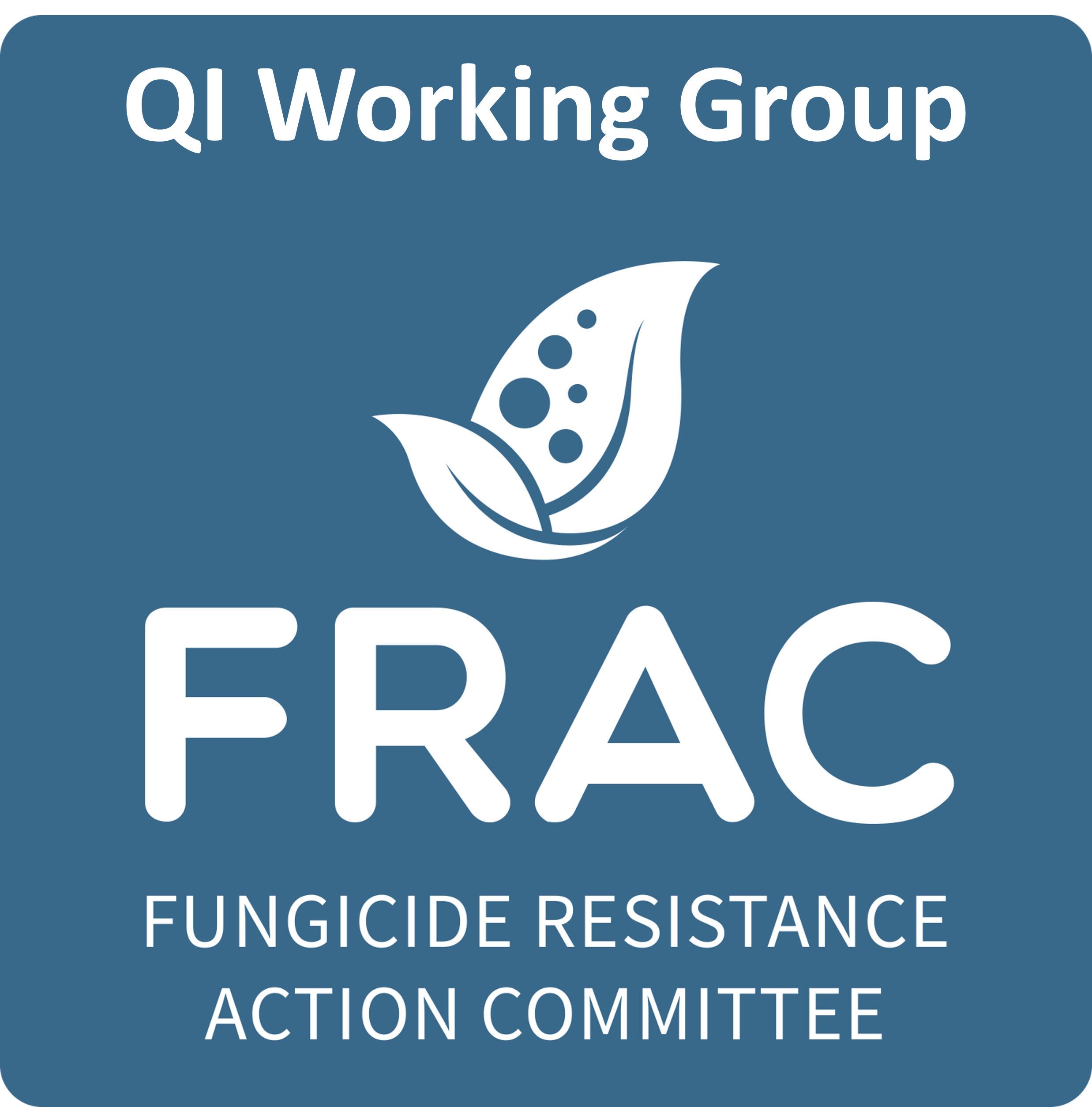QI
Introduction
The QI working group units the mode of action classes inhibiting the electron flow of the respiration chain at the cytochrome b (complex III). The three classes of fungicides are the QoI, QioSI and the QiI fungicides.
Respiration inhibitors form a very important group of fungicides (26 compounds listed at FRAC), that are able to control all plant pathogens, depending on the single fungicides activities and characteristics. Ascomycetes as well as basidiomycete and oomycete pathogens are within the activity range. Some compounds have a rather broad spectrum whereas others are more specific. Products containing QI fungicides are registered on many crops globally.
These fungicides form a central part of disease control management with about 17% (2022) contribution of the total fungicide market.
Despite the high conservation grade of the cyt b gene, selection by fungicides lead to the evolution of resistance. Most of the resistance observed are based on single site point mutations.
Depending on the risk level of the pathogen and the agronomic situation resistance arose at different time points after the introduction of the fungicides. In certain combined “high” risk situation resistance has been observed quickly after introduction of the QoI fungicides (powdery mildew in wheat, black sigatoka on banana, downy mildew on grapes), for others pathogen/crop systems it took more than 10 years until first resistance has been detected (Rhizoctonia solani on rice). No resistance (or very slow development) has been observed in Puccinia recondita on wheat and Phytophthora infestans on potato.
The exact mechanistical reasons for these differences are suspected to be selection pressure, epidemics of the respective pathogen, but also based molecular reasons: a self-splicing intron type II in the mitochondrial cyt b gene is reported to prevent the appearance of the G143A mutation (this intron has been reported on several pathogens). However, it does not prevent the occurrence of other resistance mechanisms, like F129L. The molecular reason that in certain pathogens no resistance has been reported albeit QoI are used, is not known.
QiI fungicides currently composed of fungicides used to control oomycetes and others used to control certain ascomycete pathogens. Resistance risk is assessed to be moderate to high. Some examples with either reported field resistance or from laboratory experiments suggest that resistance based on target mutations can appear, but also other mechanisms might be observed. In Zymoseptoria triticii in the lab the mutation G37V has been observed. In Saccharomyces cerevisiae, amino acid substitutions N31K, G37C and L198F at the Qi quinone binding site of cytochrome b reduced sensitivity has been reported. These mechanisms are different from those affecting the QoI (and QioSI, see below).
QioSI fungicides control oomycete plant pathogens by inhibiting both ubiquinone binding sites at complex III (Zhu et al. 2015, Fehr et al. 2016). To date, two resistance mechanisms have been identified in Plasmopara viticola that affect ametoctradin sensitivity: overexpression of the alternative oxidase, which impacts all complex III inhibitors, and the S34L mutation in the cytochrome b gene, specific to ametoctradin. The S34L mutation occurs in the inner binding site but does not impact QiI fungicides. Resistance mechanisms for QoI (G143A and F129L) or QiIs (L201S, inserts at 203/204) do not influence the sensitivity to ametoctradin.
Basic information about the fungicides, the mode of action and the mechanism of resistance are given in several review and summary articles, like:
Quinone outside inhibitor fungicide resistance: selection patterns and the current situation
Authors: Stefano F. F. Torriani and Helge Sierotzki, ID: 9781801469678 in Understanding and minimising fungicide resistance, SBN - print 978-1-80146-198-6, ed Dr Francesco J. Lopez-Ruiz, www.bdspublishing.com.
Characterization of mutants with single and combined Qi and Qo site mutations in Saccharomyces cerevisiae reveals interactions between the picolinamide fungicide CAS-649 and azoxystrobin
David H. Young, Brigitte Meunier
https://www.sciencedirect.com/science/article/pii/S0048357522002802?pes=vor
Interaction of picolinamide fungicide primary metabolites UK-2A and CAS-649 with the cytochrome bc1 complex Qi site: mutation effects and modelling in Saccharomyces cerevisiae
David H Young, Brigitte Meunier, Nick X Wang
https://onlinelibrary.wiley.com/doi/10.1002/ps.6893
Directed evolution predicts cytochrome b G37V target site modification as probable adaptive mechanism towards the QiI fungicide fenpicoxamid in Zymoseptoria tritici
BrowZine Journal Cover
Guillaume Fouché 1 2, Thomas Michel 3, Anaïs Lalève 1, Nick X Wang 2, David H Young 2, Brigitte Meunier 3, Danièle Debieu 1, Sabine Fillinger # 1, Anne-Sophie Walker # 1
https://pubmed.ncbi.nlm.nih.gov/34490974/
Zhu X., Zhang M., Liu J., Ge J., Yang G. (2015) Ametoctradin is a Potent Qo Site Inhibitor of the Mitochondrial Respiration Complex III. J Agric Food Chem, 63, 3377−3386, DOI: 10.1021/acs.jafc.5b00228
Fehr M., Wolf A., Stammler G. (2016) Binding of the respiratory chain inhibitor ametoctradin to the mitochondrial bc1 complex. Pest Manag Sci 2016, 72, 591–602. DOI: 10.1002/ps.4031
Interaction of picolinamide fungicide primary metabolites UK-2A and CAS-649 with the cytochrome bc1 complex Qi site: mutation effects and modelling in Saccharomyces cerevisiae
David H Young, Brigitte Meunier, Nick X Wang
https://onlinelibrary.wiley.com/doi/10.1002/ps.6893
Directed evolution predicts cytochrome b G37V target site modification as probable adaptive mechanism towards the QiI fungicide fenpicoxamid in Zymoseptoria tritici
BrowZine Journal Cover
Guillaume Fouché 1 2, Thomas Michel 3, Anaïs Lalève 1, Nick X Wang 2, David H Young 2, Brigitte Meunier 3, Danièle Debieu 1, Sabine Fillinger # 1, Anne-Sophie Walker # 1
https://pubmed.ncbi.nlm.nih.gov/34490974/
Zhu X., Zhang M., Liu J., Ge J., Yang G. (2015) Ametoctradin is a Potent Qo Site Inhibitor of the Mitochondrial Respiration Complex III. J Agric Food Chem, 63, 3377−3386, DOI: 10.1021/acs.jafc.5b00228
Fehr M., Wolf A., Stammler G. (2016) Binding of the respiratory chain inhibitor ametoctradin to the mitochondrial bc1 complex. Pest Manag Sci 2016, 72, 591–602. DOI: 10.1002/ps.4031
